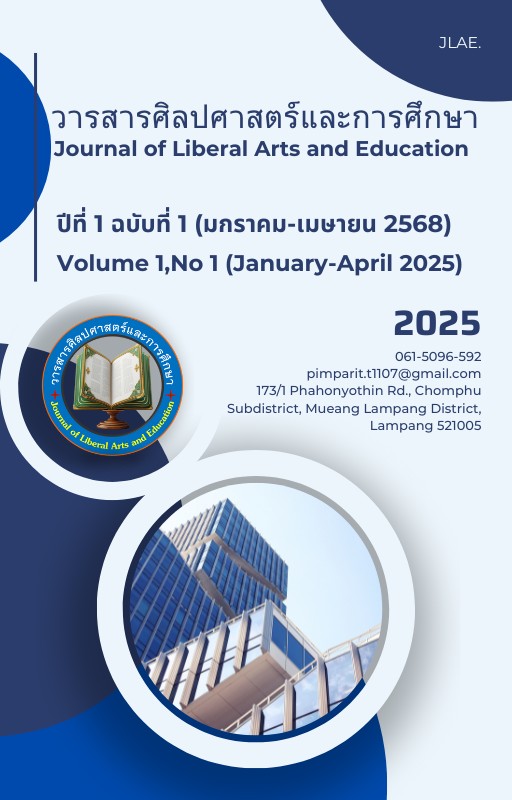Academic Leadership of The School Administrators Under The Kanchanaburi Primary Educational Service Area Offic
Abstract
The objectives of this research were.1) to study the academic leadership of school administrators under the Kanchanaburi Primary Educational Service Area 1 and 2) to compare the academic leadership of the school administrators under the Kanchanaburi Primary Educational Service Area 1 classified by gender, age, educational level and work experience. The sample groups were school administrators and teachers under the Kanchanaburi Primary Educational Service Area 1 320 people. The research instrument was a 5-scale questionnaire. The statistics used for data analysis were frequency, percent, standard deviation t-test and testing F–test.
The research results were found that: 1) Academic leadership of school administrators under the Kanchanaburi Primary Educational Service Area 1 overall and curriculum administration development of teaching and learning processes development of teaching and learning materials assessment of academic performance teaching supervision and research to improve the quality of education had a high level of practice. 2) The Results of comparison between personal data and academic leadership of the school administrators under the Kanchanaburi Primary Educational Service Area 1 By gender as a whole, it was found that no different on program administration and research to improve the quality of education, the difference was statistically significant at the .05 level. When classified by educational background overall, there was no difference. In each side, it was found that the assessment and evaluation of academic performance and research to improve the quality of education, the difference was statistically significant at the .05 level. When classified by age overall and each side found no difference and when classified by work experience, it was found that overall and the aspects, it was different for the development of teaching and learning processes and research to improve the quality of Education the difference was statistically significant at the .05 level.
References
กระแส ชนะวงศ์ (2556). ประธานอาศรมสาธารณสุขชุมชน หลักสูตรปรัชญาดุษฎีบัณฑิต สาขาวิชายุทธศาสตร์การพัฒนาภูมิภาค มหาวิทยาลัยราชภัฏสุรินทร์. บรรยาย.
ภัสรา ชูเลน. (2558). ภาวะผู้นำวิชาการของผู้บริหารสถานศึกษาสังกัดสำนักงานเขตพื้นที่การศึกษา ประถมศึกษานครศรีธรรมราช เขต 4. (วิทยานิพนธ์ครุศาสตรมหาบัณฑิต สาขาวิชาการบริหารการศึกษา มหาลัยราชภัฎนครศรีธรรมราช).
ปฐม ปริปุนณังกูร. (2553). ภาวะผู้นำทางวิชาการของผู้บริหารสถานศึกษาตามทัศนะของครู สังกัดสำนักงานเขตพื้นที่การศึกษาประถมศึกษานราธิวาส เขต 2. (ปริญญาศึกษาศาสตรมหาบัณฑิต มหาวิทยาลัยสงขลานครินทร์)
ปาริชาติ ชูปฏิบัติ. (2555). ภาวะผู้นำของผู้บริหารสถานศึกษาสตรีในโรงเรียนสังกัดสำนักงานเขตพื้นที่การศึกษาบุรีรัมย์ เขต 1. (วิทยานิพนธ์ครุศาสตรมหาบัณฑิต สาขาวิชาการบริหารสถานศึกษา มหาวิทยาลัยราชภัฏบุรีรัมย์)
ละอองดาว ประโพธิ (2556) ได้ศึกษาวิจัยเรื่อง “ความสัมพันธ์ระหว่างภาวะผู้นำทางวิชาการของผู้บริหารสถานศึกษา กับพฤติกรรมการสอนที่มีประสิทธิผลของครูในสถานศึกษาระดับมัธยมศึกษา สังกัดสำนักงานเขตพื้นที่การศึกษามัธยมศึกษา จังหวัดเลย. (หลักสูตรศึกษาศาสตรมหาบัณฑิต สาขาการบริหารการศึกษา มหาวิทยาลัยสุโขทัยธรรมาธิราช)
Draft, R. L. (2005). The leadership experience (3th ed.). Mason, OH: Thomson South-Western.
Krejcie, R. V., & Morgan, D. W. (1970). Determining sample size for research activities. Educational and Psychological Measurement, 30, 607-610.
Yukl, G. A. (2002). Leadership in organizations. Englewood Cliff, New Jersey: Prentice-Hal
Downloads
Published
How to Cite
Issue
Section
License

This work is licensed under a Creative Commons Attribution-NonCommercial-NoDerivatives 4.0 International License.
This article is published under a Creative Commons Attribution-NonCommercial-NoDerivatives 4.0 International License (CC BY-NC-ND 4.0), which allows others to share the article with proper attribution to the authors and prohibits commercial use or modification. For any other reuse or republication, permission from the journal and the authors is required.

